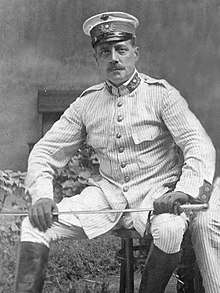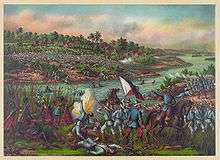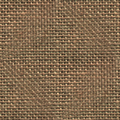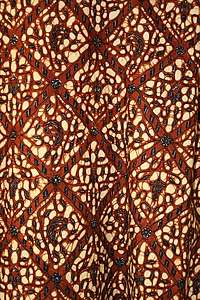Rayadillo
Rayadillo was a blue-and-white striped cotton fabric used to make the military uniforms worn by Spanish colonial soldiers from the mid 19th century until the early 20th Century. Known by the British as "pyjamas", due to their resemblance with sleeping garments,[1] it was commonly worn amongst soldiers posted in overseas Spanish tropical colonies and later, Spanish Morocco[2] and Spanish Guinea.[3] It became popular after being worn during the Spanish–American War, and was later adopted by the Philippine Army.[4] It also served as the summer uniform of the regular army in Spain until 1914.[5]

The term rayadillo is Spanish, which translates to "striped material". In the mid-19th century, this material was referred to as being of hilo listado azure, or "blue striped thread". It was known as dril azul rayado or "blue striped drill" by the end of the century. Early examples of the fabric seemed to have had light blue stripes which were widely separated, while surviving examples of uniform jackets and trousers from the 1890s have thinner stripes of a darker blue, known during that period as mil rayas – literally, "a thousand stripes". Seen from a distance, rayadillo looked either very light blue or blue-gray.[6]
The Revolutionary Army of the First Philippine Republic under Emilio Aguinaldo also employed the same fabric in their military uniforms during the later years of the Philippine Revolution and the Philippine–American War.[7]
Along with pith helmets, which were also first worn by the Spanish in Southeast Asia, the rayadillo uniform became strongly associated with Imperialism and was a symbol of colonial rule.[8]
Rayadillo military uniforms
Military uniforms made out of the rayadillo material were of a number of patterns:
Spanish Empire
Guerrera

The guerrera, or campaign jacket worn with the rayadillo uniform was made of deep blue flannel and had two breast pockets with flaps. It was fastened by a single row of seven metal buttons. The jacket was patterned on the tunic officially prescribed for general wear by the infantry of the Spanish Peninsular Army on August 18, 1886.[6] The guerrera was worn by Spanish troops stationed in the Philippines, Cuba and Puerto Rico. The Philippine-issue rayadillo patterned guerrera was distinguishable from those issued in Cuba and Puerto Rico by a standing collar and concealed button fly front. A single hook and eye is found at the bottom of the collar opening. This uniform was issued in 1891 until 1898.[9]
Guayabera
The guayabera was patterned on a traditional Cuban work jacket. The tunic features pleats down the front and center back and four large cargo pockets on the skirt. It may or may not have a concealed button fly front. Bone is the preferred material for buttons; those on the shoulder strap and pockets are sometimes covered in rayadillo fabric. A thin white cotton lining is found in the interior shoulder area. Evidence culled from period photographs indicate these uniforms being issued about 1896 until 1898.[10]
Philippine Republic

The Filipino rayadillo military tunic was instituted by what would eventually become the Philippine Republic during the Tejeros Convention.[11] It had two broad bands of matching fabric spanning the frontal area from the shoulders down to the hem. These concealed horizontal breast pockets which had vertical pocket flaps with buttons of either brass or covered with rayadillo fabric. The brass buttons were either unadorned or decorated with a "mythological sun" motif. Officers' tunics had slits in the skirt's side that allowed a hand gun holster and a sword to be attached to a belt worn under the tunic.[7] Infantry officers wore blue pants with a black stripe down the side, while Cavalry officers wore red trousers with black stripes.[12]
The artist Juan Luna is credited with this design.[13][14] His brother, general Antonio Luna commissioned him with the task.[15] Juan Luna also designed the collar insignia for the uniforms, distinguishing between the services; Infantry, Cavalry, Artillery, Sappers and Medics.[16] At least one researcher has postulated that Juan Luna may have patterned the tunic after the English Norfolk jacket, since the Filipino version is not a copy of any Spanish-pattern uniform. That Emilio Aguinaldo and his comrades, during their exile in Hong Kong, had uniforms made of rayadillo in this popular sporting pattern is another probable origin.[7][17]
Later use

The rayadillo clothing continued to be worn extensively by the Spanish Army into the early 20th century. It was worn on active service in Morocco[18]until 1911, when khaki drill was adopted. By now an essentially white uniform with fine blue stripes, it comprised the de verano (summer) dress for all branches of the Peninsular (mainland Spain) Army until 1914.[19]
In the Philippines, Norfolk-style 'Rayadillo' uniforms were worn mostly by Veterans of the Philippine Revolution as well as the Philippine–American War during the American period till the early years of the Republic as part of their heritage. Meanwhile, rayadillo-inspired uniforms are used by the Armed Forces of the Philippines as part of their ceremonial uniforms during national occasions, most notably Philippine Independence day. In 2005, Gen. Cardozo M. Luna, Commandant of the Philippine Military Academy ordered the revival of the rayadillo material in the cadets' dress uniform, discarding the United States Military Academy-inspired dress uniform long used in the PMA.[20] Rayadillo-styled uniforms are worn by personnel of the inter-service Presidential Security Group.
See also
References
- Quesada, Alejandro (2007). The Spanish–American War and Philippine Insurrection. Osprey.
- Maria, Jose. Uniformes de las Unidades Militares de la Ciudad de Melilla. p. 31. ISBN 84-86629-26-8.
- Maria, Jose. Los Cazadores de Caballeria. p. 44. ISBN 84-86629-28-4.
- Combs, William K. "¡Rayadillo!:The Spanish Colonial Uniform Research Project". Retrieved 2008-05-18.
- Maria, Jose. Nuestras Tropas en Guines. p. 24. ISBN 84-86071-03-8.
- Field, Ron (1998). "Spanish troops in the Philippines, 1896–98". Military Images. Retrieved 2008-05-18.
- Combs, William K. "Filipino Rayadillo Norfolk-pattern Tunic". Retrieved 2008-05-18.
- Quesada, Alejandro (2007). The Spanish–American War and Philippine Insurrection. Osprey.
- Combs, William K. "Philippines Issue Pattern Rayadillo Tunic "Guerrera"". Retrieved 2008-05-18.
- Combs, William K. "Rayadillo Guayabera". Retrieved 2008-05-19.
- "Philippine Military Academy Official Website: Academy News". Archived from the original on 2008-04-18. Retrieved 2008-05-19.
- "Uniformology I". Retrieved 2008-05-20.
- Alejandrino, Jose (1949). The Price of Freedom.
- Opiña, Rimaliza (2004-11-14). "Military academy sheds West Point look". Sun.Star Baguio. Archived from the original on 2008-10-29. Retrieved 2008-05-19.
- Jose, Vivencio R. (1986). The Rise and Fall of Antonio Luna. Solar Publishing. p. 106.
- "Uniformology II". Archived from the original on 2008-05-02. Retrieved 2008-05-20.
- "Filipino Rayadillo Norfolk Pattern Tunic". Retrieved 18 October 2015.
- page 371 "Illustrated London News" September 11 1909
- Bueno, Jose M. El Ejercito de Alfonso XIII. La Infanteria de Linea. p. 40. ISBN 84-86071-02-X.
- Dumlao, Artemio (2004-10-24). "PMA Goes Retro, Sheds Old West Point-inspired Uniform". The Philippine Star. Archived from the original on 2009-07-26. Retrieved 2008-05-18.
External links
| Wikimedia Commons has media related to Rayadillos. |


.svg.png)